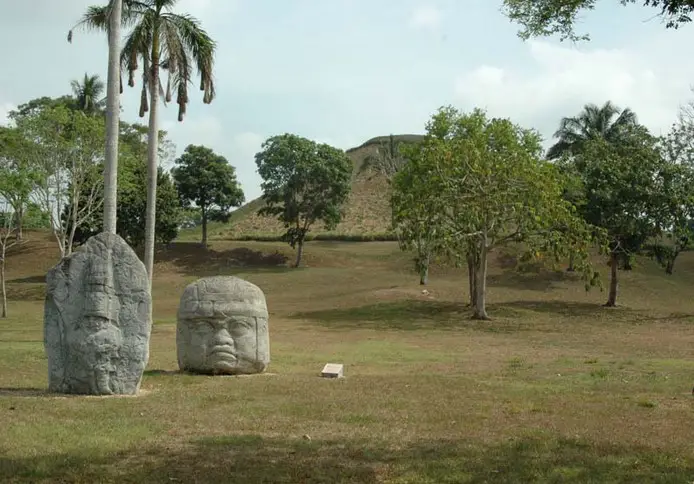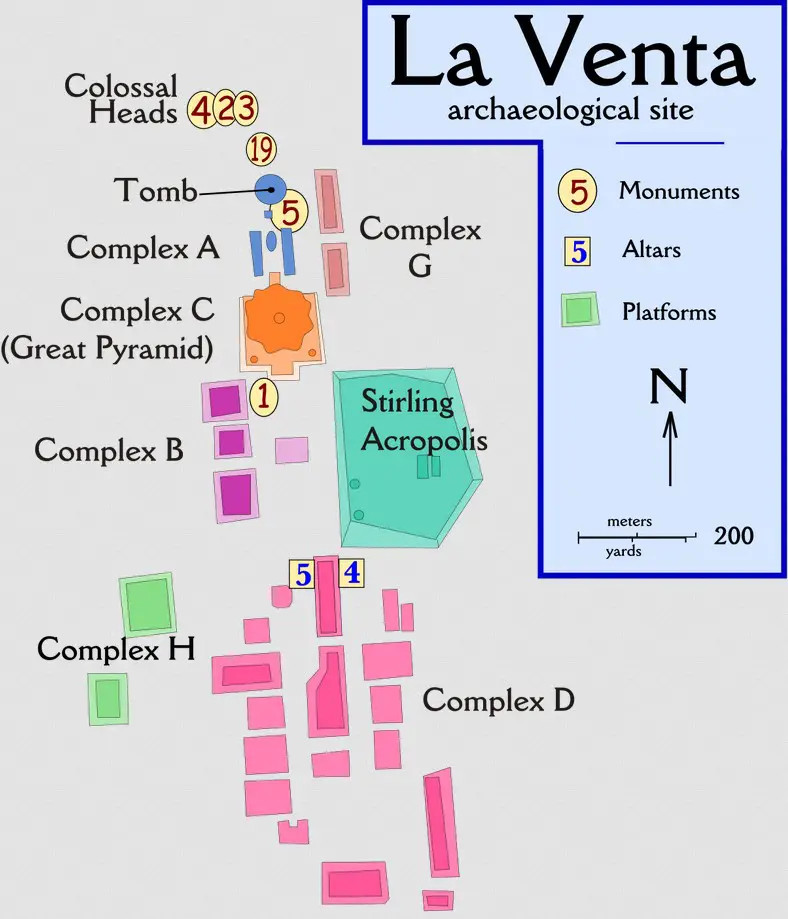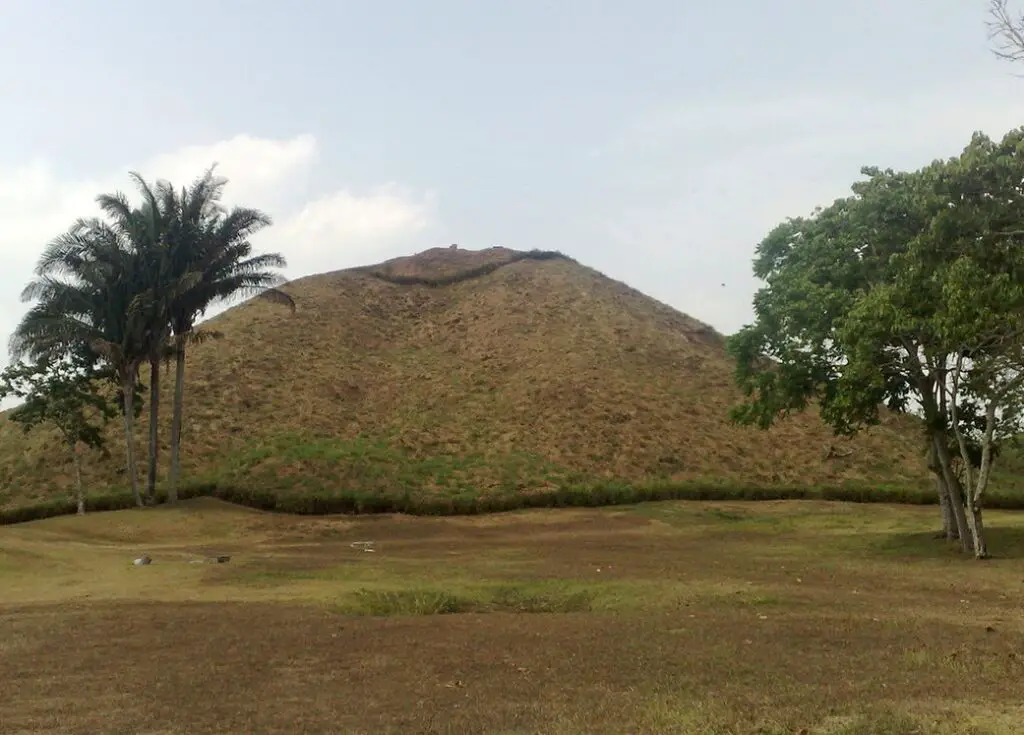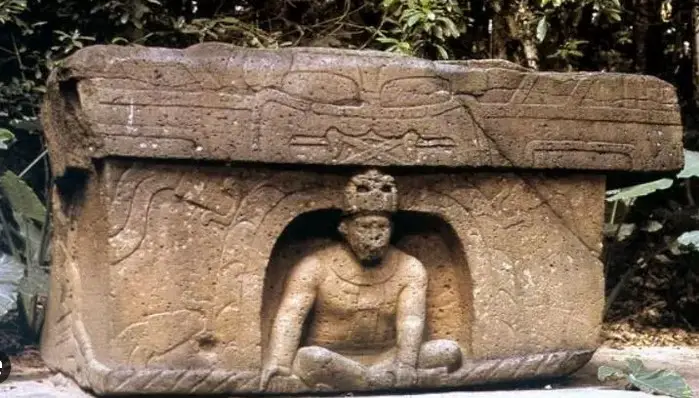Podcast: Play in new window | Download
Subscribe: Apple Podcasts | RSS
 In the year 1925, Frans Blom and Oliver LaFarge of Tulane University got permission from the Mexican government to explore an overgrown archaeological site in the tropical jungles of the state of Tabasco. They thought they were excavating a Maya site, although what would later be called La Venta was on the western fringes of what was considered Maya territory. Between 1940 and 1943 the famous Mesoamerican archaeologists Matthew Sterling and Philip Drucker led excavations at La Venta sponsored by the National Geographic Society and the Smithsonian Institution. It was only in the 1950s using sophisticated dating techniques that were newly available that the Sterling and Drucker team realized that La Venta was a much older site than previously imagined and that it predated the beginnings of Classic Maya civilization by several hundred years. In certain publications Matthew Sterling is credited with applying the word “Olmec” to this new pre-Maya civilization. The term “Olmec” – or “The Rubber People” in Nahuatl – had been used by the Aztecs many many centuries later to describe the people living in the area who supplied the Aztec Empire with the rubber to make the balls for their ball games. 20th century archaeologists adopted the term “Olmec” to describe the ancient civilization found in Veracruz and Tabasco which flourished some 2,000 years before the Aztecs. So, La Venta is an Olmec site as it relates to the ancient culture which was a term applied much later.
In the year 1925, Frans Blom and Oliver LaFarge of Tulane University got permission from the Mexican government to explore an overgrown archaeological site in the tropical jungles of the state of Tabasco. They thought they were excavating a Maya site, although what would later be called La Venta was on the western fringes of what was considered Maya territory. Between 1940 and 1943 the famous Mesoamerican archaeologists Matthew Sterling and Philip Drucker led excavations at La Venta sponsored by the National Geographic Society and the Smithsonian Institution. It was only in the 1950s using sophisticated dating techniques that were newly available that the Sterling and Drucker team realized that La Venta was a much older site than previously imagined and that it predated the beginnings of Classic Maya civilization by several hundred years. In certain publications Matthew Sterling is credited with applying the word “Olmec” to this new pre-Maya civilization. The term “Olmec” – or “The Rubber People” in Nahuatl – had been used by the Aztecs many many centuries later to describe the people living in the area who supplied the Aztec Empire with the rubber to make the balls for their ball games. 20th century archaeologists adopted the term “Olmec” to describe the ancient civilization found in Veracruz and Tabasco which flourished some 2,000 years before the Aztecs. So, La Venta is an Olmec site as it relates to the ancient culture which was a term applied much later.
Researchers believe that the Olmecs first began settling La Venta around 1200 BC. At that time, the Olmec site of San Lorenzo had emerged as the chief power in the region. When the importance of San Lorenzo started to decline around the year 900 BC, La Venta started its ascent. La Venta would dominate the Olmec world for some 500 years and was completely abandoned by about 400 BC. Unlike other ancient Mexican sites, there were no squatters living among the ruins centuries after the city’s collapse. When La Venta was abandoned, it surrendered itself to the relentless tropical jungle.
 So, what does the city of La Venta look like? The ruins are located about 10 miles inland from the coast of the Gulf of Mexico and sit on an island in a swamp overlooking a former river, at times called the Río Barí or the Rio Palma. The site covers about 2 square miles. La Venta is situated at the convergence of 4 different ecosystems: the Gulf of Mexico, tropical jungle, mangrove swamps and marshes. Oriented 8° west of true North, La Venta stretches some 12 miles along this axis and shows a high degree of symmetry on either side of the axis. Because there were very little sources of stone nearby, the city was built mostly of earth and clay, and with annual rainfall in the area being 2,000 millimeters a year, many of the structures at this important Olmec site have not survived the elements. It is unknown what a lot of La Venta’s buildings looked like, although there are plenty of surviving monuments such as stelae, altars and mound pyramids to give archaeologists a sense of the vast scope of this amazing city.
So, what does the city of La Venta look like? The ruins are located about 10 miles inland from the coast of the Gulf of Mexico and sit on an island in a swamp overlooking a former river, at times called the Río Barí or the Rio Palma. The site covers about 2 square miles. La Venta is situated at the convergence of 4 different ecosystems: the Gulf of Mexico, tropical jungle, mangrove swamps and marshes. Oriented 8° west of true North, La Venta stretches some 12 miles along this axis and shows a high degree of symmetry on either side of the axis. Because there were very little sources of stone nearby, the city was built mostly of earth and clay, and with annual rainfall in the area being 2,000 millimeters a year, many of the structures at this important Olmec site have not survived the elements. It is unknown what a lot of La Venta’s buildings looked like, although there are plenty of surviving monuments such as stelae, altars and mound pyramids to give archaeologists a sense of the vast scope of this amazing city.
Dominating La Venta is what researchers call Complex C or The Great Pyramid of La Venta. Unlike its Maya, Toltec or Aztec counterparts, this pyramid is not made of stone but is constructed almost entirely out of clay. At 110 feet tall, it towers over everything and is visible from far away. The ancients used over 100,000 cubic meters of earth fill when building the Great Pyramid. Originally, archaeologists believed that the pyramid was made to look like a sacred mountain nearby, but it turns out that the present shape is due in part to 2,500 years of erosion, and this structure did have the familiar pyramid “look” to it when La Venta was at its height. Over the years the Great Pyramid of La Venta has been severely looted, and archaeologists believe that hundreds of priceless artifacts have been whisked away to foreign collections and museums.
Just south of the Great Pyramid is Complex B. Complex B consists of a large plaza measuring some 440 yards long and 110 yards wide. It is flanked by several platforms, including one massive one on the eastern side called the Stirling Acropolis in honor of the archaeologist Matthew Stirling. Researchers believe that the platforms surrounding the plaza served as stages on which public rituals or performances were carried out. There is also a small platform in the center of the Complex B plaza.
 North of the Great Pyramid is Complex A, which consists of a plaza and mound group surrounded by a series of stone columns. Researchers believe that this complex was restricted to the elites due to the overabundance of luxury goods such as jade, elaborate figurines and polished mirrors found in burials and offerings beneath the plazas. One of the most magnificent finds of ancient Mexico was found here at Complex A: Three intricate mosaics measuring 15 by 20 feet which were fashioned out of 485 blocks of serpentine. Researchers are baffled as to the meanings of these mosaics, but they know that at one point they were ritualistically buried and hidden from view. Archaeologists theorize that these mosaics could be everything from a crude map of La Venta to an abstract jaguar mask, to a dragon or a star chart. Of special note in Complex A is Monument 19, a relief sculpture which shows the oldest known representation of the feathered serpent in Mesoamerica. Complex A was built and rebuilt several times over the course of La Venta’s 500-year history.
North of the Great Pyramid is Complex A, which consists of a plaza and mound group surrounded by a series of stone columns. Researchers believe that this complex was restricted to the elites due to the overabundance of luxury goods such as jade, elaborate figurines and polished mirrors found in burials and offerings beneath the plazas. One of the most magnificent finds of ancient Mexico was found here at Complex A: Three intricate mosaics measuring 15 by 20 feet which were fashioned out of 485 blocks of serpentine. Researchers are baffled as to the meanings of these mosaics, but they know that at one point they were ritualistically buried and hidden from view. Archaeologists theorize that these mosaics could be everything from a crude map of La Venta to an abstract jaguar mask, to a dragon or a star chart. Of special note in Complex A is Monument 19, a relief sculpture which shows the oldest known representation of the feathered serpent in Mesoamerica. Complex A was built and rebuilt several times over the course of La Venta’s 500-year history.
Because of the clay and earth construction at La Venta, no residences of the non-elites survive, although archaeologists believe that Complex E would have served as the city’s residential zone. At the city’s height, researchers believe that La Venta could have supported a population of 18,000 people.
La Venta is known for its monumental artifacts, most notably, 4 of the 17 colossal Olmec stone heads have been found there. Labeled Monuments 1 through 4, these gigantic head sculptures were carved from basalt stone transported from the Tuxtla Mountains located some 50 miles northwest of the city. No one knows how these stones were transported to La Venta through jungles, swamps and across two major rivers. One of the heads, called Monument 1, measures some 9 feet tall and was discovered about a dozen yards south of the Great Pyramid. The other three heads were found in a row just north of the elite area called Complex A. They were all facing north, away from the city. There are theories as to who or what these heads were meant to represent. The usual ideas of kings or gods are trotted out, but each head is wearing the helmets worn in the famous Mesoamerican ballgame. Could academics be failing to see what is right in front of their faces? Could these gigantic sculptures have been made to honor famous ancient Olmec sports stars?
 In addition to the notorious heads, La Venta also is home to two gigantic basalt altars known as Altars 4 and 5. The material to make these altars also came from the same place as the stone to make the heads, the Tuxtla Mountains 50 miles away. Both altars measure 6 feet tall and 12 feet wide and have elaborately carved figures in their front-center areas. Altar 4 has a man holding a rope who is in a seated position wearing a headdress or mask. It looks like this man is emerging from a cave or maybe from the mouth of a huge mythical creature. Altar 5 is like Altar 4, but the center figure has a more elaborate headdress and is holding what appears to be a baby were-jaguar, which is a creature found in many depictions of Olmec art. There are two smaller and cruder altars located near the southern edge of the Great Pyramid. Both depict human figures emerging from a cave or mouth with one holding a limp baby in his arms and the other holding nothing. As with many things Olmec, these altars are open to interpretation by scholars. Some believe that they are not altars at all but are thrones. Others believe that the presence of the baby imagery indicates that these altars were used for child sacrifice. As the Olmec civilization had a very rudimentary writing system that was not widely used and is open to a great deal of interpretation, we may never know what the reason for these altars were or the meanings behind a lot of what is found at La Venta.
In addition to the notorious heads, La Venta also is home to two gigantic basalt altars known as Altars 4 and 5. The material to make these altars also came from the same place as the stone to make the heads, the Tuxtla Mountains 50 miles away. Both altars measure 6 feet tall and 12 feet wide and have elaborately carved figures in their front-center areas. Altar 4 has a man holding a rope who is in a seated position wearing a headdress or mask. It looks like this man is emerging from a cave or maybe from the mouth of a huge mythical creature. Altar 5 is like Altar 4, but the center figure has a more elaborate headdress and is holding what appears to be a baby were-jaguar, which is a creature found in many depictions of Olmec art. There are two smaller and cruder altars located near the southern edge of the Great Pyramid. Both depict human figures emerging from a cave or mouth with one holding a limp baby in his arms and the other holding nothing. As with many things Olmec, these altars are open to interpretation by scholars. Some believe that they are not altars at all but are thrones. Others believe that the presence of the baby imagery indicates that these altars were used for child sacrifice. As the Olmec civilization had a very rudimentary writing system that was not widely used and is open to a great deal of interpretation, we may never know what the reason for these altars were or the meanings behind a lot of what is found at La Venta.
Heading into the future, there are many challenges that La Venta faces. When archaeologists returned to the site in the 1950s after World War II, they noticed that there were more digs done at the site by looters than by archaeologists. As the site still remains largely unprotected, looting continues to be a problem, especially on the periphery of the city, which is largely unexcavated and unexplored. PEMEX, Mexico’s national oil company, started drilling operations in the far southern end of the site in the 1960s, thus destroying countless artifacts and structures that would have added to the broader understanding of La Venta and the Olmec civilization. Oil drilling equipment and outdated machinery dumped here and there are now permanent fixtures on the grounds of the once-mighty city. Other challenges include urban sprawl and the unchecked activity of modern people. Take an incident that happened in January of 2009 when 23 ancient monuments were irreparably damaged by a group of people claiming to be engaging in pre-Hispanic indigenous rituals. These people splashed onto the monuments a mixture of oil, salt water and grape juice as part of a “world peace” spiritual cleansing. There is no evidence that such a ritual was every carried out by any ancient indigenous group, and grapes are not even native to the Gulf Coast of Mexico as the closest grapes growing in the wild are found in Baja California, over 2,000 miles away. Funding issues and lack of proper personnel to watch over the site are always reasons given for the vulnerability of La Venta. Perhaps with more efforts taken to preserve and study this place, a clearer picture of the Olmec civilization will begin to emerge.
REFERENCES
Diehl, Richard. The Olmecs: America’s First Civilization. London: Thames and Hudson, 2004. We are Amazon affiliates. Please purchase the book here: https://amzn.to/3UqXNAq
